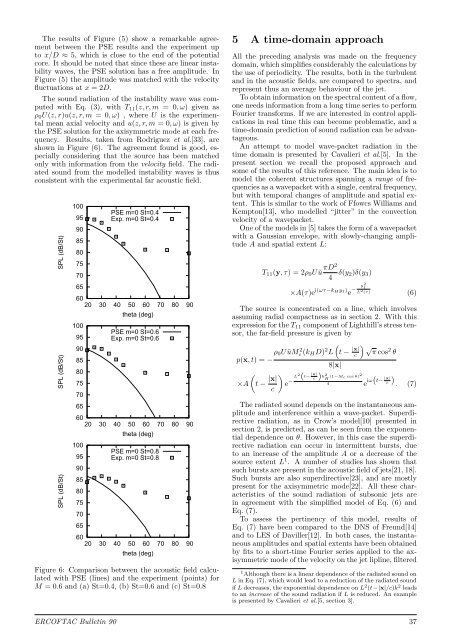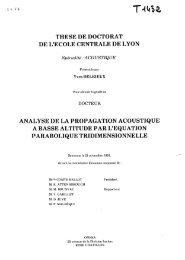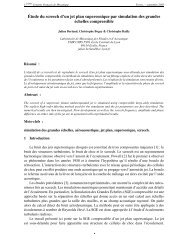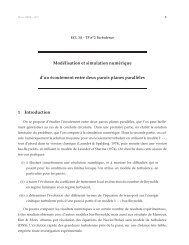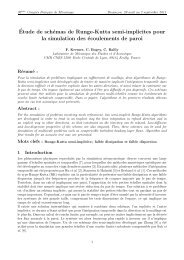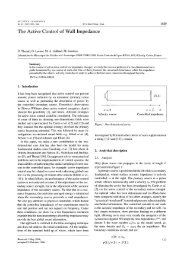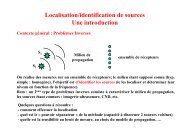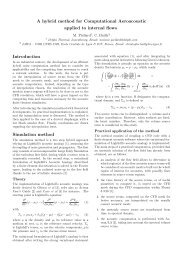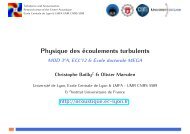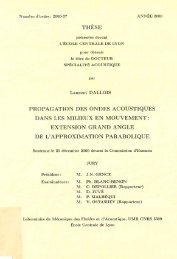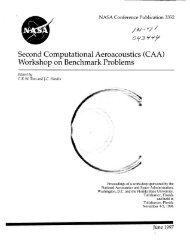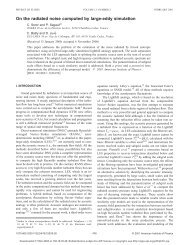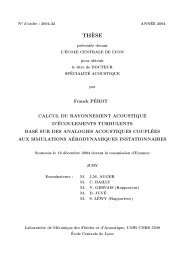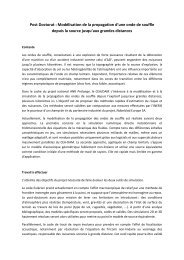ERCOFTAC Bulletin - Centre Acoustique
ERCOFTAC Bulletin - Centre Acoustique
ERCOFTAC Bulletin - Centre Acoustique
You also want an ePaper? Increase the reach of your titles
YUMPU automatically turns print PDFs into web optimized ePapers that Google loves.
The results of Figure (5) show a remarkable agreement<br />
between the PSE results and the experiment up<br />
to x/D ≈ 5, which is close to the end of the potential<br />
core. It should be noted that since these are linear instability<br />
waves, the PSE solution has a free amplitude. In<br />
Figure (5) the amplitude was matched with the velocity<br />
fluctuations at x = 2D.<br />
The sound radiation of the instability wave was computed<br />
with Eq. (3), with T11(z, r, m = 0, ω) given as<br />
ρ0U(z, r)u(z, r, m = 0, ω) , where U is the experimental<br />
mean axial velocity and u(z, r, m = 0, ω) is given by<br />
the PSE solution for the axisymmetric mode at each frequency.<br />
Results, taken from Rodriguez et al.[33], are<br />
shown in Figure (6). The agreement found is good, especially<br />
considering that the source has been matched<br />
only with information from the velocity field. The radiated<br />
sound from the modelled instability waves is thus<br />
consistent with the experimental far acoustic field.<br />
SPL (dB/St)<br />
SPL (dB/St)<br />
SPL (dB/St)<br />
100<br />
95<br />
90<br />
85<br />
80<br />
75<br />
70<br />
65<br />
PSE m=0 St=0.4<br />
Exp. m=0 St=0.4<br />
60<br />
20 30 40 50 60 70 80 90<br />
100<br />
95<br />
90<br />
85<br />
80<br />
75<br />
70<br />
65<br />
theta (deg)<br />
PSE m=0 St=0.6<br />
Exp. m=0 St=0.6<br />
60<br />
20 30 40 50 60 70 80 90<br />
100<br />
95<br />
90<br />
85<br />
80<br />
75<br />
70<br />
65<br />
theta (deg)<br />
PSE m=0 St=0.8<br />
Exp. m=0 St=0.8<br />
60<br />
20 30 40 50 60 70 80 90<br />
theta (deg)<br />
Figure 6: Comparison between the acoustic field calculated<br />
with PSE (lines) and the experiment (points) for<br />
M = 0.6 and (a) St=0.4, (b) St=0.6 and (c) St=0.8<br />
5 A time-domain approach<br />
All the preceding analysis was made on the frequency<br />
domain, which simplifies considerably the calculations by<br />
the use of periodicity. The results, both in the turbulent<br />
and in the acoustic fields, are compared to spectra, and<br />
represent thus an average behaviour of the jet.<br />
To obtain information on the spectral content of a flow,<br />
one needs information from a long time series to perform<br />
Fourier transforms. If we are interested in control applications<br />
in real time this can become problematic, and a<br />
time-domain prediction of sound radiation can be advantageous.<br />
An attempt to model wave-packet radiation in the<br />
time domain is presented by Cavalieri et al.[5]. In the<br />
present section we recall the proposed approach and<br />
some of the results of this reference. The main idea is to<br />
model the coherent structures spanning a range of frequencies<br />
as a wavepacket with a single, central frequency,<br />
but with temporal changes of amplitude and spatial extent.<br />
This is similar to the work of Ffowcs Williams and<br />
Kempton[13], who modelled “jitter” in the convection<br />
velocity of a wavepacket.<br />
One of the models in [5] takes the form of a wavepacket<br />
with a Gaussian envelope, with slowly-changing amplitude<br />
A and spatial extent L:<br />
T11(y, τ) = 2ρ0Uũ πD2<br />
4 δ(y2)δ(y3)<br />
×A(τ)e i(ωτ−kHy1) e − y2 1<br />
L 2 (τ) (6)<br />
The source is concentrated on a line, which involves<br />
assuming radial compactness as in section 2. With this<br />
expression for the T11 component of Lighthill’s stress tensor,<br />
the far-field pressure is given by<br />
ρ0UũM<br />
p(x, t) = −<br />
2 c (kHD) 2L <br />
×A t − |x|<br />
<br />
e<br />
c<br />
−<br />
L 2t− |x| <br />
k<br />
2<br />
c H<br />
<br />
t − |x|<br />
c<br />
√π cos 2 θ<br />
8|x|<br />
(1−Mc cos θ)2<br />
4 e iω<br />
|x|<br />
t− c . (7)<br />
The radiated sound depends on the instantaneous amplitude<br />
and interference within a wave-packet. Superdirective<br />
radiation, as in Crow’s model[10] presented in<br />
section 2, is predicted, as can be seen from the exponential<br />
dependence on θ. However, in this case the superdirective<br />
radiation can occur in intermittent bursts, due<br />
to an increase of the amplitude A or a decrease of the<br />
source extent L 1 . A number of studies has shown that<br />
such bursts are present in the acoustic field of jets[21, 18].<br />
Such bursts are also superdirective[23], and are mostly<br />
present for the axisymmetric mode[22]. All these characteristics<br />
of the sound radiation of subsonic jets are<br />
in agreement with the simplified model of Eq. (6) and<br />
Eq. (7).<br />
To assess the pertinency of this model, results of<br />
Eq. (7) have been compared to the DNS of Freund[14]<br />
and to LES of Daviller[12]. In both cases, the instantaneous<br />
amplitudes and spatial extents have been obtained<br />
by fits to a short-time Fourier series applied to the axisymmetric<br />
mode of the velocity on the jet lipline, filtered<br />
1 Although there is a linear dependence of the radiated sound on<br />
L in Eq. (7), which would lead to a reduction of the radiated sound<br />
if L decreases, the exponential dependence on L 2 (t−|x|/c)k 2 leads<br />
to an increase of the sound radiation if L is reduced. An example<br />
is presented by Cavalieri et al.[5, section 3].<br />
<strong>ERCOFTAC</strong> <strong>Bulletin</strong> 90 37


